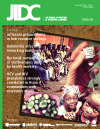Bacterial contamination of stethoscopes used by health workers: public health implications
DOI:
https://doi.org/10.3855/jidc.701Keywords:
bacteria, stethoscope, infection, transmission, hospital.Abstract
Background: This study was designed to assess both the potential for bacterial transmission by stethoscopes used by health-care workers in Nigeria and the implications for patient safety and control of hospital-acquired infections.
Methodology: A structured questionnaire was administered to health workers and the surface of the diaphragm of their stethoscopes swabbed for bacteriological analysis using standard techniques.
Results and Conclusions: Of the 107 stethoscopes surveyed, 84 (79%) were contaminated with bacteria; 59 (81%) of the contaminated stethoscopes belonged to physicians and 25 (74%) were from other health workers. Isolates included Staphylococcus aureus (54%), Pseudomonas aeruginosa (19%), Enterococcus faecalis (14%), and Escherichia coli (13%). All stethoscopes that had never been cleaned were contaminated while lower levels of contamination were found on those cleaned one week or less before the survey (χ2 = 22.4, P < .05). Contamination was significantly higher on stethoscopes cleaned with only water (100%) compared to those cleaned with alcohol (49%) (χ2 = 30.17, P < .05). Significantly fewer (9%) stethoscopes from health workers who washed their hands after seeing each patient were contaminated when compared with the instruments (86%) of those who did not practice hand washing (χ2 = 23.79, P < .05). E. coli showed the highest antibiotic resistance, while S. aureus showed the highest antibiotic susceptibility. Strict adherence to stethoscope disinfection practices by health workers can minimize cross-contamination and ensure improved patient safety in hospital environments.
Downloads
Published
How to Cite
Issue
Section
License
Authors who publish with this journal agree to the following terms:
- Authors retain copyright and grant the journal right of first publication with the work simultaneously licensed under a Creative Commons Attribution License that allows others to share the work with an acknowledgement of the work's authorship and initial publication in this journal.
- Authors are able to enter into separate, additional contractual arrangements for the non-exclusive distribution of the journal's published version of the work (e.g., post it to an institutional repository or publish it in a book), with an acknowledgement of its initial publication in this journal.
- Authors are permitted and encouraged to post their work online (e.g., in institutional repositories or on their website) prior to and during the submission process, as it can lead to productive exchanges, as well as earlier and greater citation of published work (See The Effect of Open Access).








